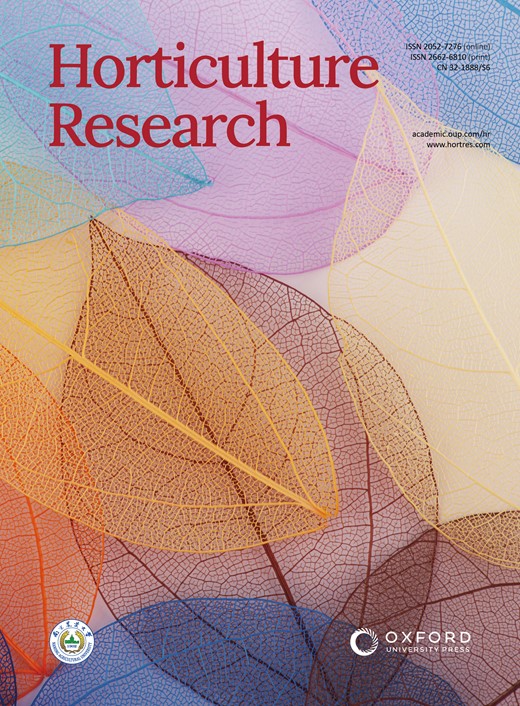基于基质辅助激光解吸/电离质谱成像的茶苗代谢物分布可视化技术
IF 8.7
1区 农林科学
Q1 Agricultural and Biological Sciences
引用次数: 0
摘要
茶苗(Camellia sinensis)根系发达,具有强大的直根和侧根。与普通扦插苗相比,它具有更强的生命力和环境适应能力,有利于优良品种的推广。然而,关于茶籽生根发芽过程的详细研究较少。本研究采用基质辅助激光解吸电离飞行时间质谱对茶苗生长过程中的主要器官进行了非靶向空间质谱成像。共鉴定出 1 234 种化合物,可分为 24 类。其中,茶氨酸作为最主要的含氮化合物,在胚萌发初期迅速合成,占胚根中游离氨基酸总量的90%以上,然后通过中柱鞘转移到各分生组织区域,表明茶氨酸基氮流在茶苗发育过程中对器官的形成起着决定性作用。贮存在子叶中的营养物质在萌芽初期迅速水解为糊精和 3-磷酸甘油醛,随后转化为其他形式的物质,如棉子糖和 d-半乳糖(葡萄糖),为发育提供碳和能量,这些物质主要分布在根尖和茎顶端分生组织的生长区。这项研究为茶苗发育过程中物质的合成和代谢提供了一个新的视角,有助于更好地了解茶树品种的生物学特性。本文章由计算机程序翻译,如有差异,请以英文原文为准。
Visualization of metabolite distribution based on matrix-assisted laser desorption/ionization-mass spectrometry imaging of tea seedlings (Camellia sinensis)
Tea seedlings (Camellia sinensis) have well-developed root system with strong taproot and lateral roots. Compared with ordinary cuttings, it has stronger vitality and environmental adapt ability, thus facilitating the promotion of good varieties. However, there is less of detailed research on the rooting and germination process of tea seeds. In this study, matrix-assisted laser desorption ionization time-of-flight mass spectrometry was used to conduct non-targeted spatial mass spectrometry imaging of the main organs during growth of tea seedlings. A total of 1, 234 compounds were identified, which could be classified into 24 classes. Among them, theanine, as the most prominent nitrogen compound, was synthesized rapidly at the early stage of embryo germination, accounting for more than 90% of the total free amino acids in radicle, and then transferred to each meristem region through the mesocolonial sheath, indicating that theanine-based nitrogen flow plays a decisive role in the organ formation during the development of tea seedlings. Nutrients stored in the cotyledon were rapidly hydrolyzed to dextrin and 3-phosphoglyceraldehyde at the early stages of germination, and subsequently converted to other forms that provided carbon and energy for development, such as raffinose and d-galactose (glucose), which were mainly distributed in the growing zones of the root apex and the apical meristems of the stem. This study provides a new perspective on the synthesis and metabolism of substances during the development of tea seedlings and contributes to a better understanding of the biological characteristics of tea varieties.
求助全文
通过发布文献求助,成功后即可免费获取论文全文。
去求助
来源期刊

Horticulture Research
Biochemistry, Genetics and Molecular Biology-Biochemistry
CiteScore
11.20
自引率
6.90%
发文量
367
审稿时长
20 weeks
期刊介绍:
Horticulture Research, an open access journal affiliated with Nanjing Agricultural University, has achieved the prestigious ranking of number one in the Horticulture category of the Journal Citation Reports ™ from Clarivate, 2022. As a leading publication in the field, the journal is dedicated to disseminating original research articles, comprehensive reviews, insightful perspectives, thought-provoking comments, and valuable correspondence articles and letters to the editor. Its scope encompasses all vital aspects of horticultural plants and disciplines, such as biotechnology, breeding, cellular and molecular biology, evolution, genetics, inter-species interactions, physiology, and the origination and domestication of crops.
 求助内容:
求助内容: 应助结果提醒方式:
应助结果提醒方式:


